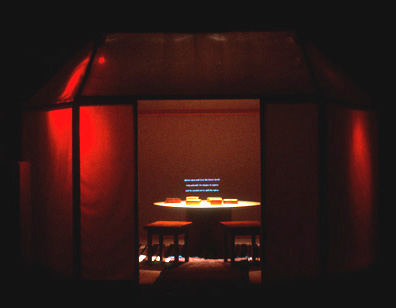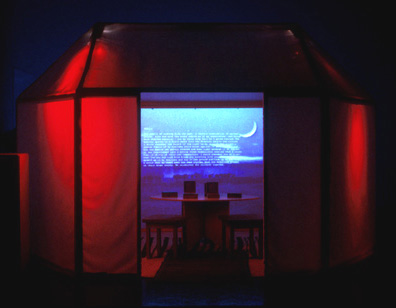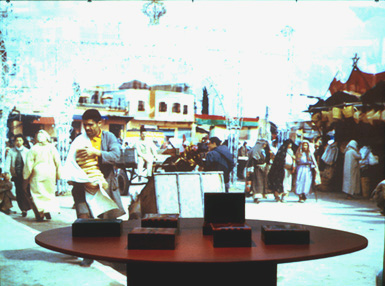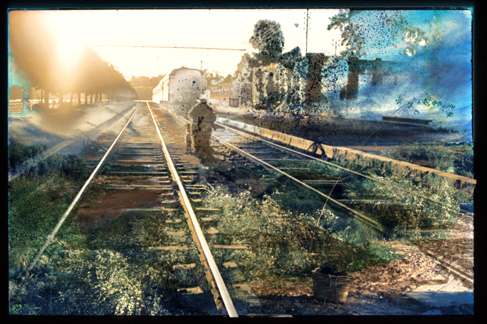
Morocco Memory II (1999) by Vibeke Sorensen
Click here to see stereoscopic images of the installation (requires Shockwave)
Morocco Memory II is an interactive computer piece that explores individual and shared memories by drawing on visual, aural, and textual documents of actual experiences in Morocco in the 1960's and 1970's, and recorded secondary experiences in popular media throughout the century. Users are invited to make connections and associations between these personal and cultural memory fragments by employing a range of sensory input, including smell and touch. This piece was installed at the Fisher Gallery at the University of Southern California as part of the Interactive Frictions Art Exhibit of the Labyrinth Research Initiative, from June 4 - 18, 1999.

Morocco Memory II includes a small house or tent made of wood and satin where a 6' x 8' back wall serves as a rear projection screen for a data projector. In front of the screen are Moroccan rugs, pillows, and a wooden table with stools for people to sit on. On the table are 6 Moroccan wooden boxes with Moroccan spices in them that people can open and close. Each time one is opened, not only are aromas released, but signals are sent to 2 computers (one for audio and one for graphics) that control colored lights in the space, and the mixing of sound, text and real-time moving images that are displayed on the rear projection screen. In this way, people can interactively explore and associate memory fragments in real-time, layering them in a way similar to what happens when a particular combination of smells triggers a string of linked and layered memory fragments in the mind. People can also feel the spices - primarily seeds, leaves, and bark, and other coarse plant materials - with their hands and fingers. It is a "ubiquitous computing" environment where almost all of the technology used is concealed or placed inside objects made of natural materials. None of the boxes have any wires or computer mice to physically connect them to the computers. Instead, there are custom chips in them that send radio waves to a receiver at a distance, which keeps track of the boxes and sends MIDI signals corresponding to their state on to the computers placed outside the tent where they cannot be seen. As a result, people can walk about freely inside the tent while holding, touching and smelling the boxes and their contents while dynamically altering the layers of images, texts, movies and sounds as they do so. It is a complete sensory experience that engages the entire body. It is also a social experience, as several people can interact with the 6 boxes and memories at the same time.

There are 64 lexia, or short stories, and thousands of related materials in this piece. Each of the lexia is associated with a large set of images, sounds and movie clips, each in several different modes for recombination and reprocessing. While most are my memories and documents, Marsha Kinder, author and Professor of the Division of Critical Studies in the School of Cinema-Television at USC and director of the Labyrinth Research Initiative, contributed additional memories and documents as well as a number of theoretical texts. Popular media memory fragments, such as text and images from books, musical recordings and movies representing other western and Moroccan artists whose work influenced me - and as a result became part of my memory - are also incorporated. This includes Paul Bowles, William Burroughs, Bryon Gysin, Anais Nin, Matisse, Bertolucci (who adapted Bowles' 'The Sheltering Sky' for film), Crosby, Stills, and Nash ("Marrakesh Express"), the Gnawa musicians of Marrakesh, and The Master Musicians of Joujouka, among others. All of these memory fragments shed light on the interplay of the senses, memory, and imagination, and the attraction of N. Africa to artists and other people who for one reason or another found themselves there for extended periods of time. The focus is on western expatriates, but also includes people who have over many centuries been expelled from other countries, such as Muslims and Jews from Spain during the Inquisition. The spices can be considered a living legacy, a physical memory of the many cultures that intersected there. The computer was used to free these memories from stasis, and to begin to reflect the way memory really works as a recycling, iterative and dynamic process that is constantly being updated and connected with other, new or recorded, related experiences and memories. While the many, mediated memory fragments in this piece exist on the hard disks of the computers, nothing happens unless someone opens or closes a box. Each person engaging the piece creates a unique association of memories that only comes alive when they interact with it.
Credits: Dell Computers provided by Intel Corporation; custom peripheral interfaces by James Snook of the Neurosciences Institute, La Jolla, California. Software includes Pure Data (Pd) by Miller Puckette of the U. C. San Diego Department of Music; Graphics Environment for Multimedia (GEM) by Mark Danks of Stormfront Studios; and custom neural net software by Phillip Mercurio of the Neurosciences Institute, La Jolla, California. Additional assistance from Rand Steiger of the U. C. San Diego Department of Music; William Galloway of the Sweeney Art Gallery of U. C. Riverside; and Laurel Almerinda of the USC School of Cinema-Television.

Biography: Vibeke Sorensen is an artist working with experimental new media, including computer graphics and animation. From her early work with hybrid video synthesizers through her long engagement with stereoscopic computer graphics and animation, to her internet based pieces, she has created a series of prints, installations, films, videotapes, and interactive artworks while also contributing to the development of new systems and methods. Her work has received many honors and awards, and has been shown internationally on television, in galleries, and in live performance. Her works primarily explore memory and perception, and the relationship between music and visual art. Ms. Sorensen studied at the Royal Academy of Art and Architecture, School of Architecture, in Copenhagen, Denmark from 1971- 74, and at the Center for Media Study at the State University of New York at Buffalo from 1974 - 76. She has taught at Virginia Commonwealth University, Art Center College of Design, Princeton University, and the California Institute of the Arts. She is currently Professor in the Division of Animation and Digital Arts at the School of Cinema-Television of the University of Southern California.
Copyright 1972/1999 Vibeke Sorensen
Send mail to Vibeke Sorensen